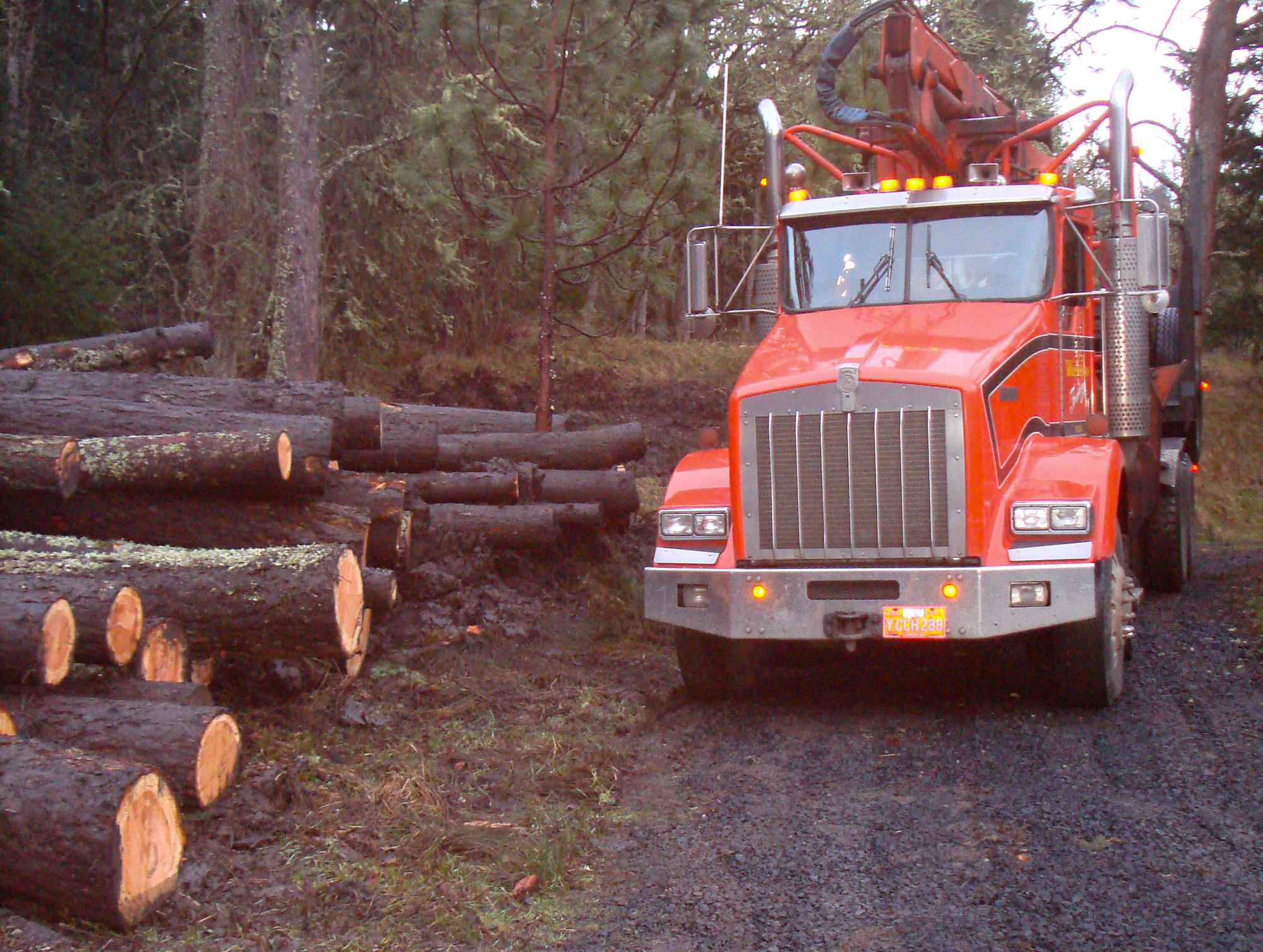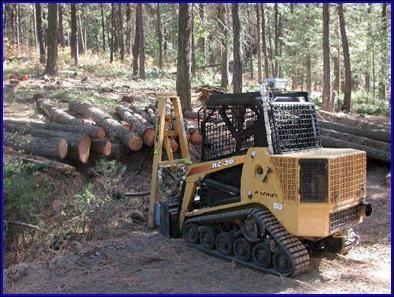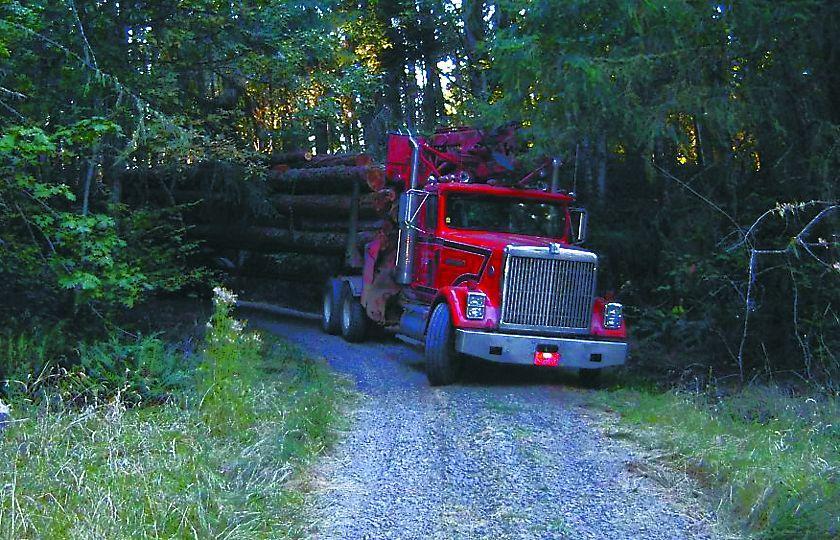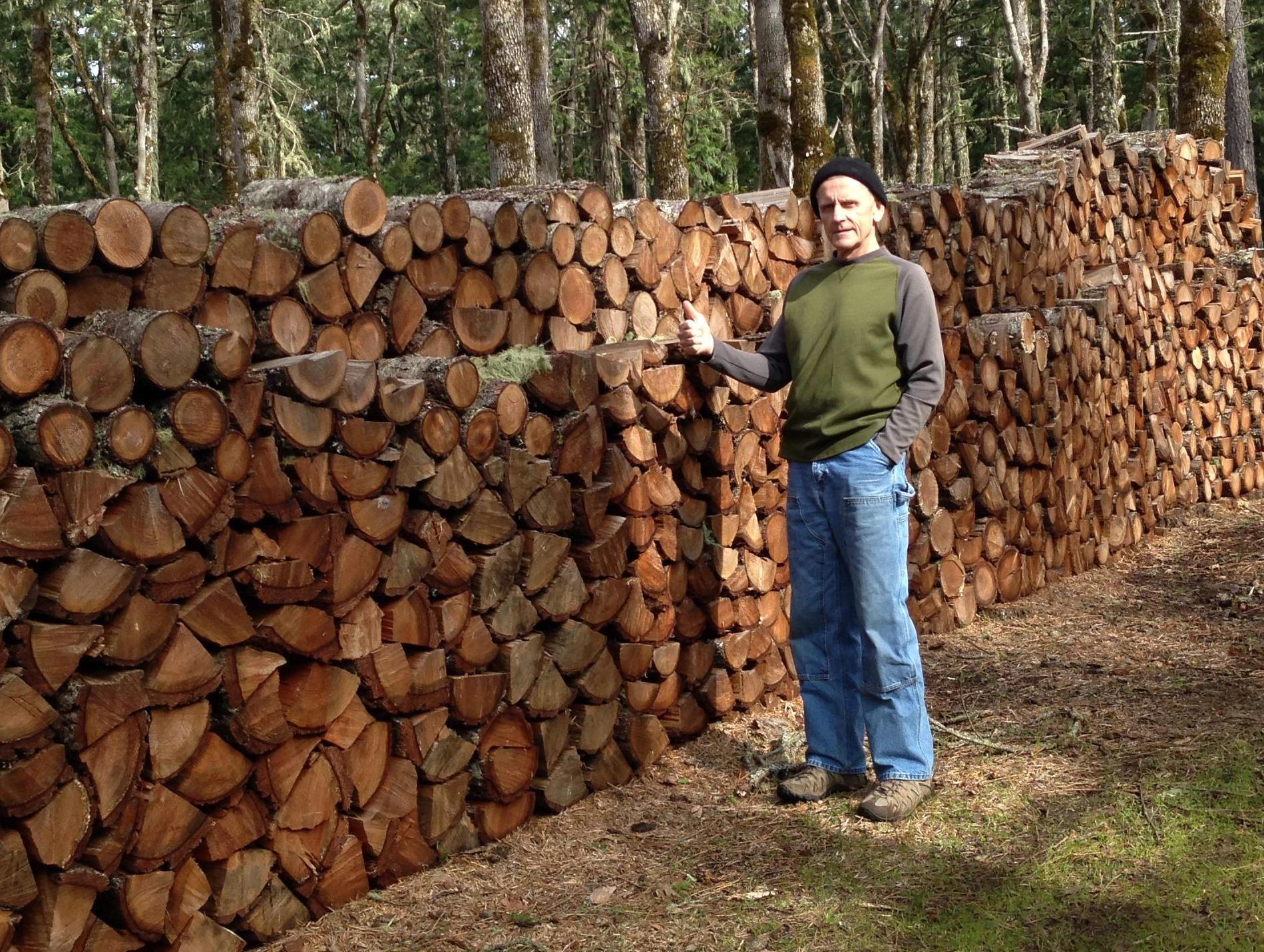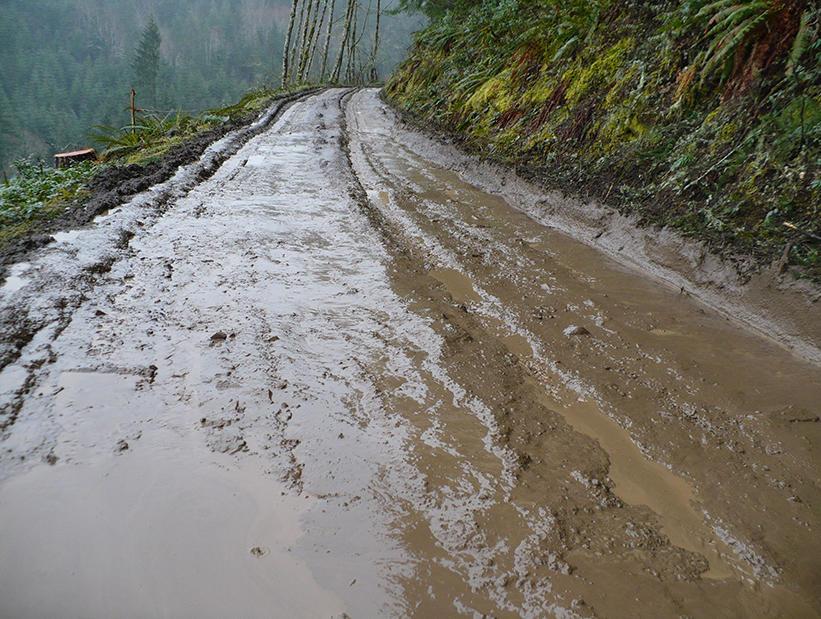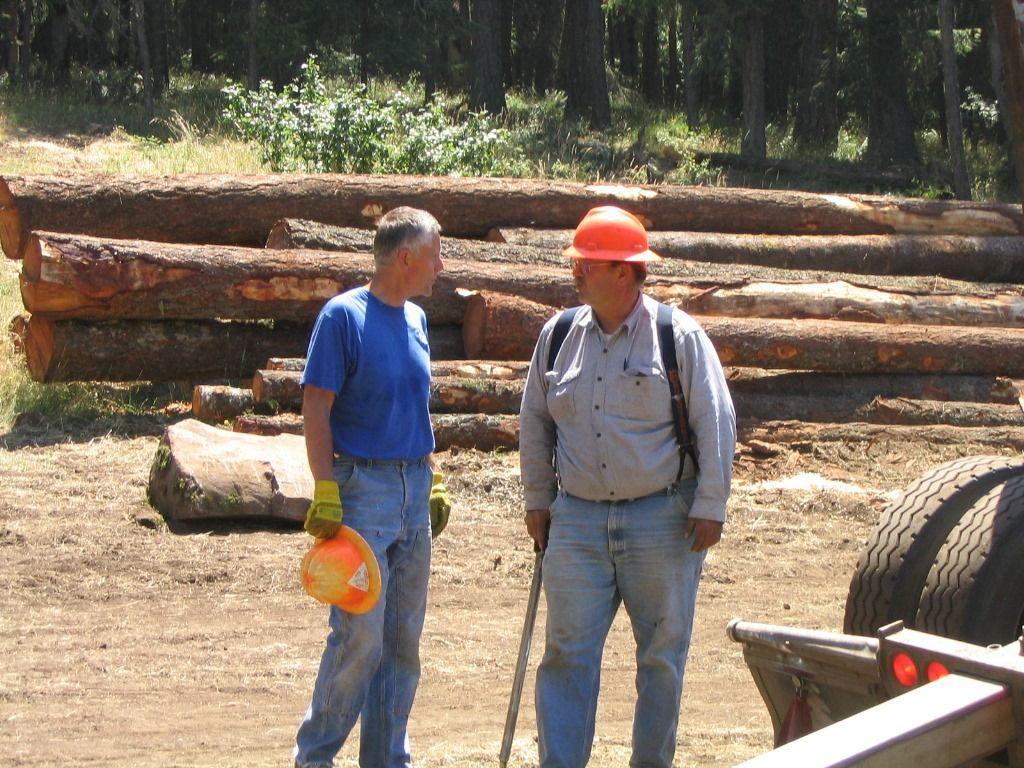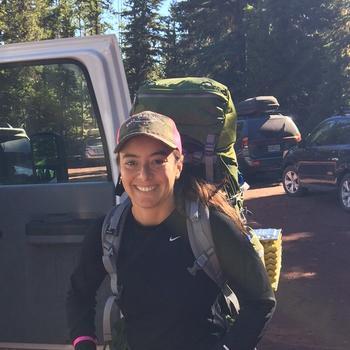Introduction
Logging and selling timber can be intimidating for small woodland owners who do not have a lot of experience in this process. Most owners are well versed in planting trees, vegetation control and stand management because they perform these tasks frequently. However, planning a timber harvest and selling the logs is a task that occurs less frequently and might present itself as more challenging.
Small woodland owners have diverse ownership acreages, from 1 to 5,000 acres. For the larger ownerships, harvesting and selling timber might be more frequent and to a scale that allows the owner to hire a professional forester to help with the contracts and timber sales. In small timber volumes and small acreages, it might not be possible to hire a forester for economic reasons. Economy of scale, equipment, harvest unit layout and marketing logs are aspects of small harvest operations that sometimes can be difficult to manage.
This publication discusses the unique aspects of small-scale harvesting and offers some information to help you through the process.
Background
Small woodland owners are key players in Oregon’s forest landscape and forestry sector. They provide a diverse range of forest management activities, supply timber to local mills and jobs for forestry professionals. Small woodlands expand the job market for foresters, loggers, tree planters and many other forest contractors. Timber from small private woodland owners in Oregon is a small but important percentage of the state’s annual timber harvest (10%–13%). An average harvest from industrial forests (timber companies) yields several hundred thousand board feet (MBF) to several million board feet (MMBF) of timber. In contrast, most small woodland owner operations amount to no more than 25 truckloads (or approximately 112 MBF), and many harvests are less than five. Because fixed costs (move-in costs, rocks costs, wages, etc.) remain the same for the small-scale operation, revenues are often neutral, or they may result in out-of-pocket expenses for the landowner in the end.
There are some important differences to consider when logging and selling timber from small woodlands as compared to industrial forests. The primary objective of industrial foresters is sustained-yield timber management. Although small woodland owners also view timber as a valuable asset of ownership, equally important are other natural resources such as recreation, fish and wildlife habitat, or forest and vegetation diversity. Due to these objective differences, industrial forests tend to be managed efficiently for timber supply in a tree farm, while stands on small woodland properties typically contain a greater mixture of age, wood quality and tree species.
Oregon is phenomenal at growing Douglas fir trees, so the forest sector has capitalized on this fact by utilizing this species plus a few others to produce wood products that the global market desires. Mills typically specialize to create efficiencies, so they may only accept a few tree species and will have set desired log lengths and diameters that work best for their mills and the products they create. Consequently, woodland owners with small harvest units and volumes containing multiple species of varying log quality might find it difficult to maximize revenue. Those with exceedingly small log volumes (less than a truckload) will have to work with the local mill that best capitalizes on the value.
The unique aspects of small woodland ownership, along with some general considerations required for any timber harvest, should be considered in order to generate the greatest amount of revenue (irrespective of profitability) and minimize any site impacts from the operation. Although it is not always possible to resolve any challenge that timber harvests on small woodlands present, many steps can be taken to improve the process overall. Selling Timber and Logs, EC 1587, is a good resource to familiarize yourself with the logistics of a timber sale, regardless of size or owner objectives.
There are mainly two ways of selling timber. One is a stumpage sale in which standing trees are sold and the buyer takes care of marketing and harvesting the trees. The other is a log sale in which the landowner does the logging or contracts a logger. The landowner also does the marketing. Both options have pros and cons depending on how involved the landowner wants to be and his or her willingness to take risk. This publication focuses on log sales.
Factors to consider in a timber harvest
The first question to address is why you want to harvest your timber. Objectives such as timber stand improvement, revenue generation, wildlife habitat enhancement and clearing an area for a building project are all reasons for tree removal. Depending on your goals, type of harvest and timber volume, you may or may not generate a profit. Though your objectives may be less about profit and more about minimizing impacts on the landscape, no one wants to lose money in the harvesting process. So, as much as possible, consider the harvest in terms of offsetting the work with the value of the timber. There are two important aspects to consider: maximizing value of your logs and minimizing operating costs.
Let’s consider operating costs first. Some factors in determining the cost of a logging contractor’s services include tree diameter, trees per acre and terrain conditions.
Harvest profitability depends on many factors. Some of them include:
- Distance to the mill.
- Total volume harvested.
- Tree size.
- Log quality.
- Market conditions.
- Ease of operation.
- Seasonality.
A minimum amount of timber volume is needed to cover the fixed costs of logging, which include equipment mobilization to your property. For that reason, an operation resulting in one truckload is not likely to be profitable.
There are two main types of harvest management strategies: regeneration and thinning. Regeneration harvests aim to reestablish your tree stand by way of clearing most if not all of the trees and then replanting. Thinning harvests aim to promote forest health or other objectives that are best achieved through partial cuts and without the need for replanting.
These two general harvest types require different equipment, time and other considerations. For instance, regeneration harvests will result in higher total volumes and provide ample space for a faller to lay down a tree as there will be little to no residual stand left. In contrast, thinning operations require felling and logging to be carefully performed in between standing trees to reduce damage to remaining trees. Thinning operations also typically involve smaller trees and lower total volume. For small-diameter trees, a “light” thinning constitutes removing approximately 2–5 MBF per acre or about one-half to one truckload of logs (self-loading truck) per acre. A logging contractor will usually require at least two-thirds of the value of the wood and quite possibly the full value of it, making it a marginal return in the short term. For this reason, thinning should be considered as an investment in the remaining trees, by concentrating light and nutrient resources to fewer, healthier trees.
Often overlooked is access to the trees. Over the past few years, trucking costs have constituted an increasingly larger portion of the total expense for a timber harvest. Two contributing factors are the degree of difficulty in accessing the timber on the property — taking into account narrow, steep or substandard roads — and the distance to the mill. Choosing a mill involves evaluating the dollars-per-MBF values from each mill and the associated cost of getting the logs from the landing (places where logs are processed and stored for hauling to the mill) to the mill. Usually, the most economical choice will be the mill closest to your property.
Planning the operation
Prior to the timber sale you will likely need to do some work to get things ready. These on-the-ground preparations consist of identifying the location of new access roads or maintenance of current roads, locations of landing sites, identification of harvest unit (with flagging or paint) and selection of trees to remain or to be harvested (again, with flagging or paint).
Access roads are often built to a standard suitable for owners who access their property with a conventional vehicle. Accommodating heavy equipment, however, requires a much stronger and more durable road than one used by your family car or pickup truck.
These requirements include a greater turning radius on curved roads, a wider running surface and, for wet-weather operations, a different surface design including layers of aggregate (rock). It cannot be emphasized enough: The impacts of an 80,000-pound logging truck are far greater than those of a 5,000-pound pickup truck. Managing Woodland Roads: A Field Guide, PNW 641, is an excellent source of information about the design, maintenance and repair of woodland roads.
In high-volume logging operations, larger landing sites are critical because of the space required to accommodate larger log decks and the variety of equipment at a landing site. Some of the equipment that may be present on a high-volume operation’s landing include yarders, shovels (log loaders), multiple processing systems, bulldozers, skidders and log trucks in different combinations. A typical low-volume operation requires enough space to deck one or two loads of logs, the yarding system (normally a skidder and/or a bulldozer) and a self-loading log truck. Smaller landing sites are easier to locate and construct than larger ones simply because they require less space to process the timber.
A critical aspect in locating these smaller landings is average yarding distance. This is the distance a piece of equipment must move to transport (skid) the logs to the landing site. When employing ground-based systems, flat (less than 30% slope) or favorable (downhill) grades and short yarding distances are critical for logging production. If a logging contractor determines logs must be skidded long distances or on adverse (uphill) grades or both, the job will be bid accordingly. Seeking input from potential contractors on road and landing locations beforehand can save valuable time in terms of the operation, which correlates to more money in your pocket. A cursory view of the planned site by the contractor or a professional forester will likely be very beneficial to you.
Timing and log values
When selling logs, timing is almost as important as quality. The vast majority of logs in small-scale sales are harvested during the dry season for two reasons. First, woodland owners, like anyone else, prefer to work during warm, dry periods instead of cold and wet. Second, few have durable, rock-surface roads and cannot access their timber during the wet months when annual prices are higher.
So why not invest in rocked roads to take advantage of those increased annual log values? Research shows that the increase in log values over the past 20 years would require large timber inventories to be able to pay the cost of a durable road surface. For example, to economically justify the investment of rocking a half-mile of road to access a timber stand would require a harvest of several hundred thousand board feet. Obviously, that isn’t a fixed number — depending on annual log values and the design and length of the road, it could require a smaller volume — but even the best-case scenario requires more timber than is available to many owners.
Availability of contractors
The increased activity during the summer season means loggers and log trucks sometimes are in short supply. In most instances, you will be hard-pressed to find a contractor if you have not done any pre-harvest planning. As in any occupation, the best operators are nearly always busy and are booked well in advance. Start the process early and take time to design a good plan. The further ahead you plan and the more clearly you articulate your goals, the better positioned you will be to hire a high-quality contractor.
When selecting a contractor at the spur of the moment for a small-scale job, it is likely that the bids will vary widely. Normally busy contractors who are between jobs and find a short period of availability may give a high bid because they know they will soon be working again and might not be particularly interested in a job that lasts only a few days. At the other end of the spectrum, contractors needing work may approach the situation one of two ways. First, because they want the job, they may submit a competitively low bid. Second, they may submit a high bid in hopes of making up for lack of business.
So, as in any operation, plan ahead! The best time to seek and select a contractor is during the wet season prior to the event.
Tree ownership
It is essential to know which trees are really yours, based on the location of your property boundaries. The only legally acceptable property line that will hold up in court is one established by a licensed surveyor, not a forestry consultant, industrial forester or the logger as determined by a road, fence or building. Many property lines of woodland properties were established by the Donation Land Claim Act of 1850. When roads and fences were put in, they were sometimes placed in areas of easiest access and not congruent to the Donation Land Claim Act lines. In short, do not trust old harvest boundaries, fences, roads or anyone other than a licensed surveyor to establish your legal property lines. Some forestlands may have recently been split up into subdivisions. If you know this to be true, you may have an easier time determining property line location.
If you harvest trees and it can be legally proven that ownership resides with another landowner, you may be fined double the fair market value (stumpage) of the trees. If you knowingly remove trees that are not yours, fines are triple stumpage. So again, the importance of determining legal ownership cannot be overemphasized.
Talk to your neighbors to see if they have documentation of actual property lines. If not, you and a neighbor may want to split the cost to have the property line surveyed.
Written management plans
OSU Extension Forestry recommends that you develop a written management plan for your property for several reasons, including estate planning, tax liabilities from a timber harvest, inventory, stand management attainment, and listing goals and objectives of woodland ownership. Soil and topography maps, along with stand inventory information, can be very helpful for designing an efficient timber harvest. Mills may ask whether you have a written management plan or a qualified professional logger harvesting your trees in order to buy your logs. Loggers obtain qualification through the Associated Oregon Loggers’ Oregon Professional Loggers Program. You can check if the logger you are working with is qualified or find a qualified logger. Qualification can be important when you plan to sell wood to a mill with Sustainable Forestry Initiative Certification.
Notification of Operations
All timber harvests require a notification. Log buyers will request the notification number you get when you complete your Notification of Operations with the Oregon Department of Forestry. This can be done online through the Forest Activity Electronic Reporting and Notification System or at your local ODF office.
As a forest landowner, it is important to get to know your local ODF stewardship forester. They can assist you in the process for harvest notification and answer any other questions about the Oregon Forest Practices Act and its requirements. The notification number you receive acts as a tracking device for ODF to ensure compliance with the Oregon Forest Practices Act and the Oregon Department of Revenue for possible tax liabilities. It is a requirement in order to sell your logs — no exceptions.
The value of your trees
Measuring your trees to estimate volume (which largely determines value) may cause you to reconsider your original plans. Money may not have been part of the initial plan, but it has a way of altering it. Let your objectives for the harvest area determine which trees will remain and which will be harvested, not the value of the trees (unless maximizing your profit is your objective). After all, once a tree has been removed, it will be a long time before there is another of equal stature.
Once you have determined whether the trees are the right size and species for a mill, consider the quality. It is beyond the scope of this publication to discuss the intricacies of log grading and scaling, but a few basic questions about log quality or desirability are addressed below.
Rot in one end with no discoloration in the other is acceptable. Rot at both ends of a log likely means that log is a “cull.” A cull designation relegates the log to biomass, firewood, a chipping facility or woody debris to be left in the forest. Cull logs at the mill will have zero or negative value due to fixed operating and transportation costs.
Also, logs do not have to be perfectly straight. Regardless of the log length, a good rule of thumb is that if half the length of the log is straight, it will likely make a merchantable sawlog. Sweep (imagine the log is pliable and you bend it from both ends) is a common defect in logs. Even though no part of a log with sweep is straight, the curvature is gradual and uniform enough that lumber can be processed from it and is thus acceptable to the mill.
Regardless of tree species, a merchantable sawlog usually requires a diameter of at least 5 inches at the small end. The minimum diameter is especially important to remember with stands of young red alder and heavily stocked lodgepole pine, where trees typically have good form but small diameters, and also when thinning young timber of any species.
Often, owners have questions about dead or dying trees. Purchase orders from log buyers typically prefer “fresh cut, green logs.” The degree to which this statement is important depends on species and quality. For example, fallen or dead debarked western redcedar logs, even with portions of the sapwood rotted away (often called buckskins), are highly desirable to mills that process cedar, yet virtually any sawmill will refuse a small-diameter Douglas fir log whose bark has fallen off and exhibits decay unless it is sold for pulp. Any hardwood that is dead and dried out is undesirable. The same principle applies to pine species. A general rule for conifer species, excluding redcedar, is that any log showing signs of insect attack with bark that is dry and beginning to slip from the log is highly questionable in terms of marketability unless sold as pulpwood.
If you are unsure about determining tree volume on your timber sale by yourself and have a big enough operation to cover the costs, you can always contact a consulting forester. Some of them specialize in timber cruising and can provide a detailed inventory of a forest proposed for harvest. They are worth the money as they can provide the best price and work with you to find a logging contractor as well as help oversee the logging operation.
Whether you seek assistance from a forester, having a basic understanding of how log value is determined is important in merchandizing logs. While the exact details of determining timber volumes and values are beyond the scope of this publication, anyone interested in more information on tree measurements should consult Measuring Your Trees, EM 9058. In addition, the Measuring Your Trees Workbook, EM 9059, is an Excel spreadsheet that includes a printable final report as a companion to EM 9058. OSU Extension Service periodically offers courses on the basics of tree measurements.
Selecting a mill
If you decide to do a log sale and market your logs, you will need to find a mill. To select one, you should get at least three quotes from local mills, if possible. A good source of information for mill contacts is the Oregon Forest Industry Directory. A log buyer will offer you a price for logs delivered to the mill depending on log quality, diameter, length and species. The value a buyer gives to your trees will depend on the requirements of the mill and the log market at the time. If you have different species and log types (pulp and sawlogs, for example) you might have to deal with more than one mill.
If you decide to do a stumpage sale, the buyer of the standing trees will do the marketing as well as finding and selecting a contractor.
Selecting a logging contractor
If you employed a particular contractor in the past and were satisfied with the results, that person likely will be a good choice for a similar operation. Similarly, neighbors can be good sources — if they are satisfied with a logger they hired, you will probably be satisfied, too. Loggers are often hired by owners who observe their work on an adjacent property. If you are impressed by the work, stop and talk to them about possible future employment. Be sure to request the names of their past small woodland customers. In addition, many ODF offices keep a list of contractors and are familiar with those on the list. The Associated Oregon Loggers website has a statewide listing of qualified loggers. There are other sources, but the basic principle is that you should consult with individuals or organizations that make timber harvesting their business since they will be the best informed with the most recent information.
After you have found a logging contractor, it is important to find out whether they have the appropriate equipment for the job. Technological advances in logging equipment and operating on narrower profit margins have led to contractors becoming more creative in how they conduct their operations. For example, shovel logging has increased substantially in the past several years largely because under proper working conditions, a shovel can move more wood than other ground-based equipment or yarders. Also, mechanized systems, including feller-bunchers, stroke delimbers and forwarders, are used in situations where traditional ground-based systems (dozers and rubber-tired skidders) were once the system of choice.
You need to communicate with the contractor about which equipment will be used and educate yourself about possible effects on the residual timber stand and future growth potential of reforestation efforts. Timber Harvesting Options for Woodland Owners, EC 1582, can help you determine what types of systems are best suited for your operation.
Costs and payment
In logging contracts, payment is most often based on either dollars per unit (MBF) or a percentage of the value of the wood. Historically, loggers have often worked on a percentage basis, and 50% of the value of the wood has been a standard operating procedure. Today, competition, changing demographics of woodland ownership, equipment options and mill requirements have made bidding slightly more complex, but the percentage method remains popular among contractors.
However, consider dollars per unit. A dollars-per-unit basis removes the market from the payment structure. For example, Douglas fir log values were $800/MBF in January 2015 and $600/MBF in June of the same year. All things remaining the same, if you negotiated a 50% payment structure, why pay a logger $400/MBF in January versus $300/MBF in June for the same job. As the owner, you are taking on the risk of a seldom-performed operation, and if you have been fortunate enough to hit a strong market, you should enjoy the benefits. Market strength or weakness should not be a factor in how much money the logging operation costs. If operating costs have increased for the contractor, that increase will be reflected on the contractor’s bid.
Peripheral elements in an operation
Working around structures
Oftentimes, there are unique, peripheral elements that can affect small operations. The logistics of working around power lines, buildings, roads, fences and adjacent properties make an operation more difficult and time consuming. These conditions may require additional measures like winching, timber jacks and tree pulling. These tasks take more time for the contractor, meaning greater cost to the landowner.
Working around and with neighbors
Smaller acreages correlate to having more neighbors. Studies also show that small-acreage owners have a greater variety of management objectives and reasons for ownership. Historically, people owned woodland property for financial reasons, while today many owners have other values like aesthetics, wildlife habitat and seclusion. Your neighbors may also have differing opinions about you cutting and removing trees and disrupting their peace and quiet. Most small operations are conducted during the dry months, so dust is often an issue unless abatement measures are taken. Traffic is another one. Typically, loggers begin work at dawn or earlier, especially since fire restrictions can often shorten the length of the workday. All of these factors will disrupt the daily routines of your neighbors.
Be proactive and inform neighbors of your plans; address any potential concerns and seek their input. Oftentimes, the mere fact you have been considerate and extended a line of communication is sufficient to have an orderly and peaceful operation.
Foreign material
Many small operations conducted around man-made structures come with concerns about foreign material. Trees growing in proximity to buildings may contain spikes, nails and fencing remnants, or transformers from abandoned power lines. Log buyers are always wary of purchasing logs from areas near structures or development.
A spike or nail can ruin a bandsaw used in the mill, cause serious injury and cost the company more than the profits from processing the logs. If that happens, the buyer will immediately suspend the delivery of any remaining logs from the site.
Summary
Harvesting small timber volumes on small acreages has many unique aspects and challenges. Market timing, contractor selection, timber type, purchase order structure and your individual objectives all play a part in the financial viability of your operation. If you invest the time and energy, you can feel more comfortable in the planning and process of logging and selling your timber while also achieving your goals and objectives.
